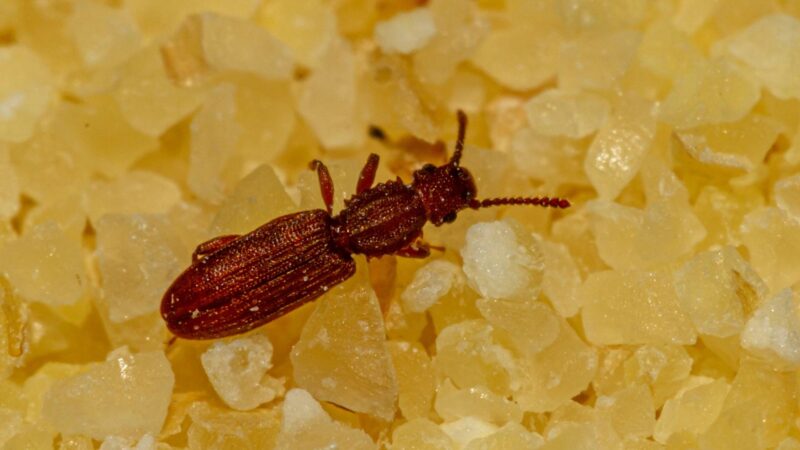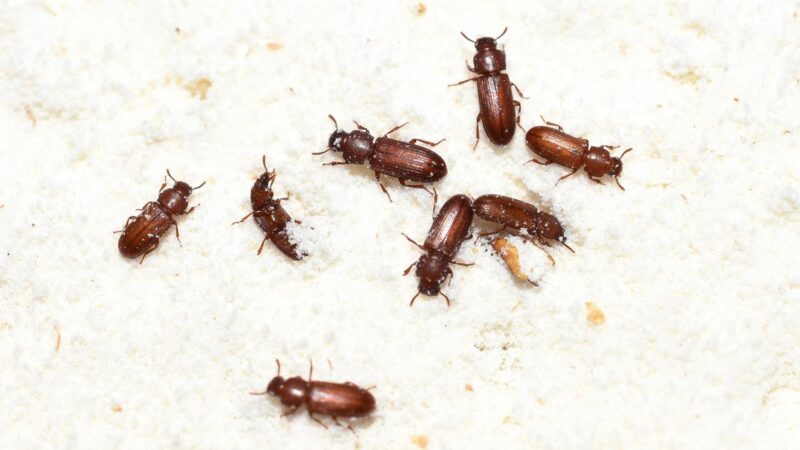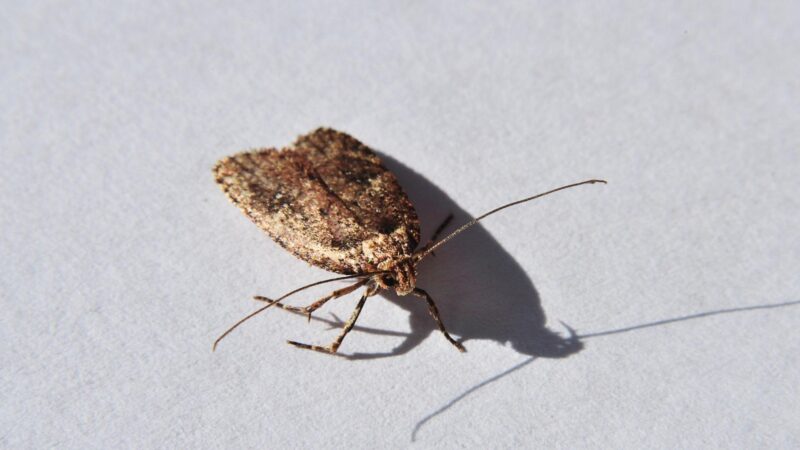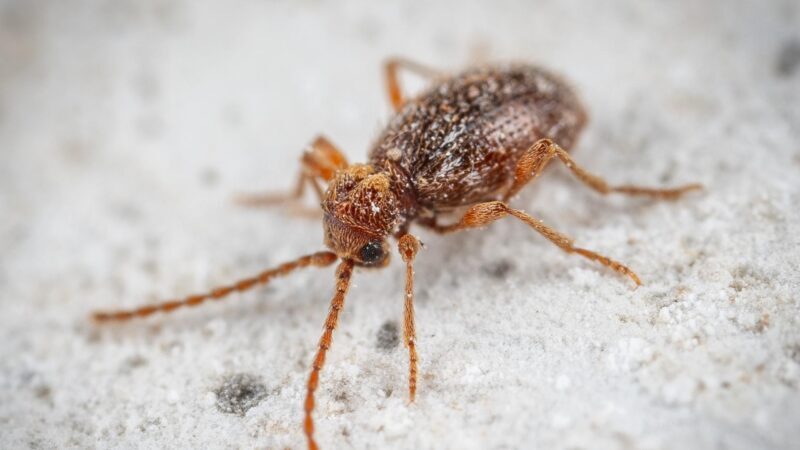If you find some insects flying and crawling in your pantry or kitchen, they are very likely to be pantry beetles. These insects can be present, even if your pantry looks very clean.
Eggs of these pantry pests are very small, which makes them difficult to spot. Seeing only one adult or larva suggests that there could be more.
How to prevent and eliminate pantry beetles? To help prevent pantry beetles, check the packages carefully before buying, and don’t buy those with a broken seal. To eliminate pantry beetles, the first thing to do is inspect stocks of all dry goods products. Then, throw away all the infested ones and clean the area thoroughly.
Pantry beetle species have some similarities in looks and diet, but they have different behaviors and habitats. You should know how to identify them correctly before taking any action.
Otherwise, it may worsen the problem. To help you out, this article explains everything about pantry pests and how to get rid of them.
Table of Contents
What Are the Tiny Black Bugs in the Kitchen?
The tiny black bugs in the kitchen are referred to as pantry pests or pantry beetles. As the name implies, these insects are commonly seen in stored food products and packages in pantries and kitchens.
Note, however, that some of them are dark red, light or dark brown, or nearly black, depending on the species.
What Do Pantry Beetles Look Like?
There are several pantry beetle species, which can be confused with one another since some of them are almost look-alikes.
Although all of them are considered pantry pests and can contaminate food, they have some distinct characteristics that will help you identify them. Below are some of the common pantry beetles.
1. Sawtoothed Grain Beetle

Scientifically known as Oryzaephilus surinamensis, the sawtoothed grain beetle belongs to the Silvanidae family. This beetle is a close relative of foreign grain beetles and merchant grain beetles.
Also known as malt beetles, these pest insects are widespread in different food industries, as well as home pantries.
During their lifetime, female sawtoothed grain beetles lay an average of 375 eggs, which hatch within 3 to 5 days. These larvae will soon start to feed and will undergo 2 to 5 instar stages, which can last for 12-15 days.
The pupal stage may take 4-5 days. The full life cycle is about 25 days, depending on the temperature.
What Do Sawtoothed Grain Beetles Look Like?
Sawtoothed grain beetles are usually reddish-brown, about 1/10 inch (2.54 mm) long, with a triangular head and a slender, flat body. As the name implies, they have six saw-like “teeth” on the sides of their bodies.
These margins are actually projections on their thorax, along with three longitudinal ridges on top of them.
Adults have mouthparts and well-developed wings, but they cannot fly. Males have a “tooth” on the femur (thigh bone) of their hind legs, while females don’t.
Sawtoothed grain beetle larvae have a brown head and a yellowish-white body. Once they become matured, these larvae can be about 1/8 inch (3 mm.) long.
2. Merchant Grain Beetle
Scientifically known as Oryzaephilus Mercator, the merchant beetle is also a member of the Silvanidae family.
But unlike its close relative, sawtoothed grain beetles, this insect species are very strong fliers and may fly to various areas. Female merchant beetles lay eggs only about 30% of sawtoothed grain beetles.
When it comes to temperature, merchant beetles like warmer climates while sawtoothed grain beetles prefer the cold ones. Hence, they are less tolerant of cold.
Nevertheless, these two beetle species have the same developmental stages and can live together. Both of their females lay eggs in masses or singly.
What Do Merchant Grain Beetles Look Like?
Merchant grain beetles look like sawtoothed grain beetles, which means that an untrained eye may mistake one for the other.
Just like sawtoothed grain beetles, merchant grain beetles also have 6 saw-like “teeth” on the edges of their body. However, the head capsule of merchant grain beetles is larger and rectangular.
Merchant grain beetles have a larger vertical diameter of the eye than sawtoothed grain beetles. Also, the small projections behind their eye are narrow and pointed.
Other than these differences, these two insect species look very similar. Their eggs and larvae are virtually the same, especially in size and color.
3. Flour Beetle

Also called bran bugs, flour beetles belong to the Tenebrionidae family and have several species.
The two most common flour beetle species are the red flour beetle (scientific name: Tribolium castaneum) and the confused flour beetle (scientific name: Tribolium confusum). Both of them are notorious pantry pests.
The red flour beetle got its name from its color, while the confused flour beetle is named such due to the confusion about its identity.
These two insect species are usually grouped because of their similarities in habitat and physical appearance. However, red flour beetles may fly, but confused flour beetles don’t.
What Do Flour Beetles Look Like?
Red flour beetles and confused flour beetles are almost look-alikes. Both of them are about 1/8 inches long, with red-brown, flattened, and oval bodies. Their wing covers have lengthwise marks.
The head and upper part of the thorax are heavily covered with very tiny holes, but confused flour beetles have deeper punctures.
The most obvious differences between these two insects are the antennae and the shape of the thorax. Red flour beetles have 3 segments on their antennae, while confused flour beetles have four.
Meanwhile, the thorax of red flour beetles has curved sides. On the other hand, confused flour beetles have straight sides.
4. Indian Meal Moths

Scientifically known as Plodia interpunctella, the Indian meal moth has been dubbed the most important pest of stored products in America.
Also spelled Indianmeal moth, this pantry pest belongs to the Pyralidae family. It has other common names such as flour moth, grain moth, pantry moth, and weevil moth.
Indianmeal moths are called such because they are originally common pests of food products that contain Indian corn or maize. But ironically, they are not native to India.
Interestingly, these pantry pests can pupate and reproduce in clothing. This is why some people mistake them for clothes moths, which are a bit smaller.
What Do Indian Meal Moths Look Like?
Adult Indianmeal moths look like Mediterranean flour moths, except that the former is a bit larger and they have a different body color.
They are about 1/2 inch (12.7 mm) long and have an average wingspan of about 5/8 inch (15.8 mm). These handsome moths are also commonly mistaken for clothes moths.
Indianmeal moths have reddish-brown wing covers, with gray on the inner third, and a copper sheen on the remaining outer two-thirds. Females lay oval, white eggs that are 0.3-0.5 mm. long.
Commonly called waxworms, their larvae are white, greenish, or pink, and mature ones can grow up to 1/2 inch long.
5. Mediterranean Flour Moth
Scientifically known as Ephestia kuehniella, the Mediterranean flour moth belongs to the Pyralidae family. Despite its name, experts have different opinions about the origin of this pantry moth.
Some of them believe it originated in North America, while others said that it came from Central America or the Mediterranean region.
Mediterranean flour moths are also present in Australia and Europe, especially Britain. They can survive in various temperatures but will reproduce more in warmer climates.
Also called milled moths, these flour moths are mostly found in bakeries and flour mills. However, they are not as common as Indianmeal moths.
What Do Mediterranean Flour Moths Look Like?
As mentioned earlier, Mediterranean flour moths and Indianmeal moths are somehow look-alikes. Nevertheless, the former is smaller and is only about 1/4-1/2 inch long, with an average wingspan of between 18 and 27 mm.
They usually have pale gray bodies, with two indistinct black zigzag lines on their forewings.
Their wing marks may eventually be rubbed off, so the best way to identify them correctly is to look at them when they are at rest. In this position, they extend their forelegs, making their body and head look like a slope.
Meanwhile, their larvae have a dark head and a whitish or pinkish body, with small dark or black spots.
6. Spider Beetle

There are around 500 species of spider beetles in the world, and all of them belong to the Anobiidae family.
In the United States, the three most common species are the smooth spider beetle (Gibbium aequinoctiale), the Whitemarked spider beetle (Ptinus fur), and the American spider beetle (Mezium americanum).
Spider beetles are widespread across America, but their populations are not as many as the other pantry beetles.
But aside from home pantries, they are also found in museums, warehouses, and areas where there are droppings of birds, bats, and rodents. These tiny beetles are so tiny, making them difficult to identify.
What Do Spider Beetles Look Like?
As their name suggests, spider beetles look like small spiders because they have large abdomens and long legs. In general, they have an oval, shiny body that can be black or reddish-brown.
Depending on the species, adult spider beetles can be between 2 and 5 mm. long, with their abdomen and wings covered with hair.
Larvae of these three species virtually look the same. They have a brown head and a creamy white C-shaped body and can grow 3.5-4 mm. long, depending on the age.
They only differ in the color of their thorax, legs, and head. Nonetheless, American spider beetles and smooth spider beetles are generally look-alikes.
What Do Pantry Beetles Eat?
Generally speaking, pantry beetles feed on a wide variety of stored dry goods. This includes bread, cake mix, chocolate, cornmeal, dried fruits, dried cereals, herbs, flour, noodles, spices, and dry pet food.
Although they can eat slightly damaged grain, these beetles cannot eat sound grain kernels or whole grains.
On the other hand, spider beetles may also eat bird droppings and rodent feces. Adult pantry beetles don’t eat but can damage food by laying eggs on them.
Larvae will start to eat shortly after they hatch and may cause an infestation if not attended to at once. They will stop eating only while they are in the pupal stage.
Are Pantry Beetles Harmful?
Pantry beetles are not harmful or dangerous to humans and pets. These household pests also don’t bite or sting, and they don’t transmit serious diseases.
Nevertheless, eating foods that are contaminated with hair and droppings of these insects can cause mild irritation of the mouth, throat, and digestive system.
Where Do Pantry Beetles Come From?
Most pantry beetles are poor fliers, which means that they rarely fly to enter your homes. Instead, these pantry pests are accidentally introduced from the food manufacturers to the groceries and supermarkets.
Once these pantry moths are inside food packages, they can quickly crawl into other areas and cause severe damage, especially to old stocks. Some of them can also chew paper and plastic.
How Long Do Pantry Beetles Live?
Different species of pantry beetles have different lifespans. If left undisturbed, most of them can live up to 3 years, although their average lifespan is only between 6 and 10 months.
Adult pantry beetles usually die shortly after laying eggs, while their larvae live as long as there are sufficient food and weather permits.
How Do You Get Rid of Pantry Beetles?
Pantry pests are not only nuisances but also destructive. In fact, they damage food more than they eat them. Once you spot them in your stored food packages, you should immediately take action.
Otherwise, an infestation is very likely to happen. Here are some useful tips on how to get rid of these pantry beetles:
- Inspect all food packages carefully, especially those that were previously opened and have been stored for quite some time.
- Check for small holes in packages and actual food. You may also find larvae in action or adults flying and crawling around them.
- Throw away all infested foods. This will also stop pantry pests from reproducing and spreading.
- For food packages that are suspected to have pantry beetle eggs but you don’t see them, place the packages in an oven at 130°F (54.4°C) for at least 30 minutes.
- Alternatively, put them in the freezer at 0°F (-17.8°C) for at least 4 days.
- Vacuum every corner of the storage areas, especially the shelves. Use a vacuum cleaner with a crevice tool attachment such as Shark NV352 Navigator Lift Away Upright Vacuum.
- To get rid of the adult ones, place glue traps with pheromones such as Trap A Pantry Moth Traps. These traps are specifically designed for pantry beetles.
How Do You Remove and Prevent Pantry Beetles?
Since pantry beetles are present in food, spraying insecticides is not advisable. Hence, ammonia, bleach, and disinfectants are also not recommended. Also, another batch is likely to appear soon.
Aside from the tips mentioned, here are some effective ways to remove pantry pests and prevent them from coming back:
- After throwing away the infested ones, transfer the remaining contents to sealed containers such as glass jars or air-tight plastic containers.
- After vacuuming the shelves, wash them thoroughly with hot water and detergent. This will help remove the remaining larvae and eggs.
- To prevent a pantry beetle infestation, inspect food packages one by one before buying, and don’t buy those that have signs of damage.
- Check expiry dates on food packages, and avoid buying items that will soon expire.
- Buy grain products that can be consumed within a short period. Old stocks are more prone to having pantry pests than new ones.
- Don’t mix newly bought goods with the old ones. As much as possible, consume the older stocks first.
- For grain products that are rarely consumed, place them inside the freezer.
- If there are spills, pick them up at once and clean the area properly.
- Clean food storage areas regularly and always keep them dry, especially when adding new stocks.
Summary
Pantry beetles can be avoided through regular inspection, habitual sanitation, and proper storage. As long as there is dry food inside your house, these pantry pests will keep on coming back.
This means that killing these unwelcome guests is not enough. The key is to be aware and careful when buying food products.
List of Sources
Sawtoothed and Merchant Grain Beetle